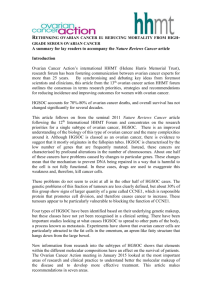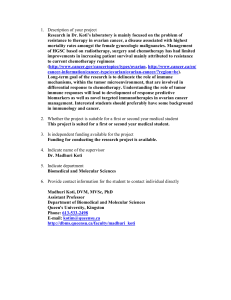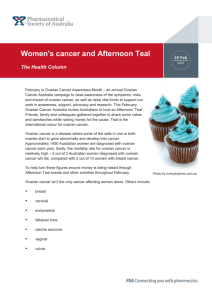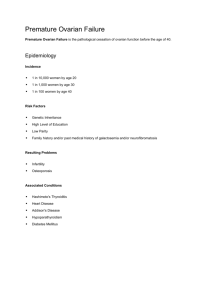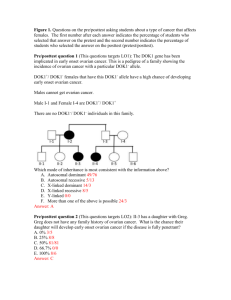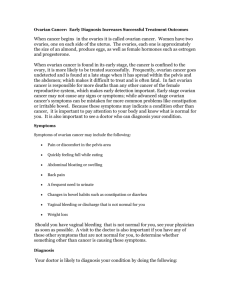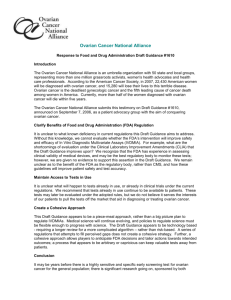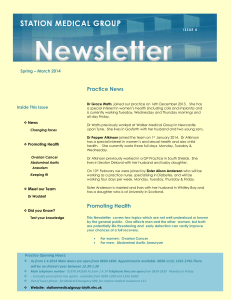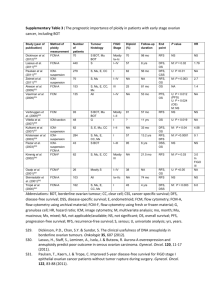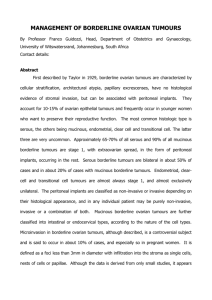Rethinking ovarian cancer II: reducing mortality from high
advertisement
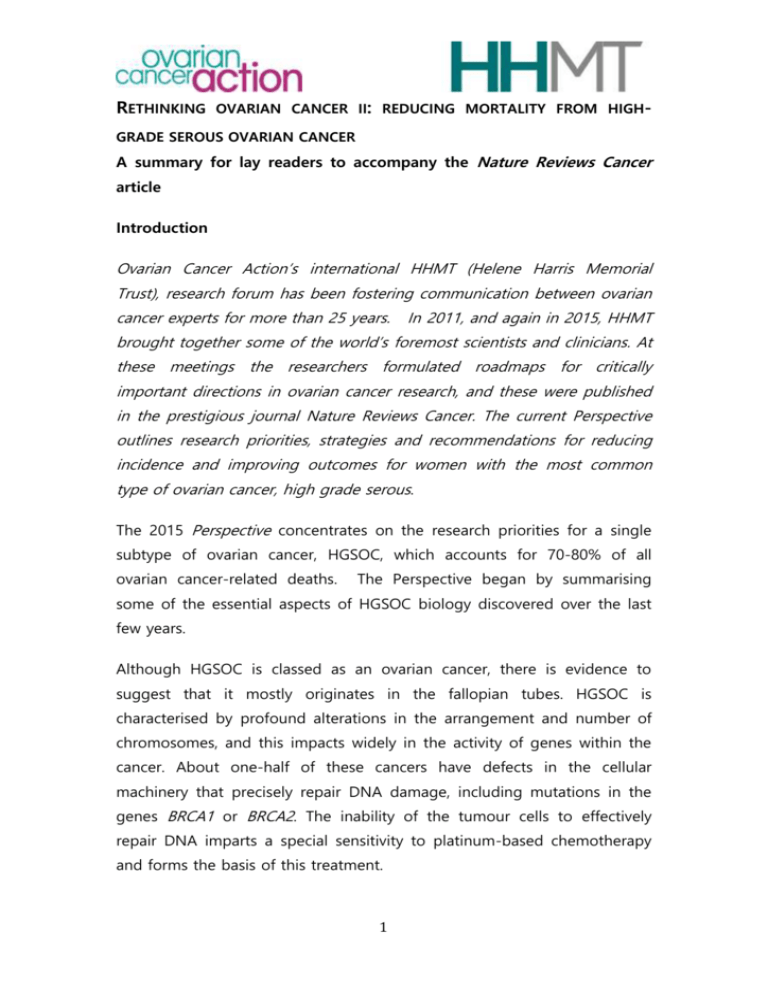
RETHINKING OVARIAN CANCER II: REDUCING MORTALITY FROM HIGH- GRADE SEROUS OVARIAN CANCER A summary for lay readers to accompany the Nature Reviews Cancer article Introduction Ovarian Cancer Action’s international HHMT (Helene Harris Memorial Trust), research forum has been fostering communication between ovarian cancer experts for more than 25 years. In 2011, and again in 2015, HHMT brought together some of the world’s foremost scientists and clinicians. At these meetings the researchers formulated roadmaps for critically important directions in ovarian cancer research, and these were published in the prestigious journal Nature Reviews Cancer. The current Perspective outlines research priorities, strategies and recommendations for reducing incidence and improving outcomes for women with the most common type of ovarian cancer, high grade serous. The 2015 Perspective concentrates on the research priorities for a single subtype of ovarian cancer, HGSOC, which accounts for 70-80% of all ovarian cancer-related deaths. The Perspective began by summarising some of the essential aspects of HGSOC biology discovered over the last few years. Although HGSOC is classed as an ovarian cancer, there is evidence to suggest that it mostly originates in the fallopian tubes. HGSOC is characterised by profound alterations in the arrangement and number of chromosomes, and this impacts widely in the activity of genes within the cancer. About one-half of these cancers have defects in the cellular machinery that precisely repair DNA damage, including mutations in the genes BRCA1 or BRCA2. The inability of the tumour cells to effectively repair DNA imparts a special sensitivity to platinum-based chemotherapy and forms the basis of this treatment. 1 The remaining half of HGSOC tumours appears to have intact DNA repair and are therefore less vulnerable to platinum chemotherapy. The genetic problems of this fraction of tumours are less clearly defined, but about 30% of this group show signs of larger quantity of a gene called CCNE1, which encodes a protein that promotes cell division, and therefore causes cancer to increase. These tumours appear to be particularly vulnerable to blocking the function of CCNE1 and therapeutic strategies are being developed to exploit this weakness. Four types of HGSOC have been identified based on their underlying genetic makeup, but this classification is yet to enter the clinic. There have been important studies investigating what causes HGSOC to spread to other parts of the body, a process known as metastasis. Experiments have shown that ovarian cancer cells are particularly attracted to the fat cells in the omentum, an apron-like fatty structure that hangs down from the large bowel. With this background information, the researchers then outlined what they felt were the most important areas of research and clinical practice for improving survival of women with HGSOC, with recommendations in seven areas. 1. Develop better experimental models Many of the current cancer cell lines (cancer cells grown in culture for laboratory experiments) have proven unsuitable for further study and it is recommended that new ones should be developed, which more accurately represent this cancer. The experimental conditions should also mimic physical conditions that surround the tumour, known as the tumour microenvironment (TME). Samples from patients’ tumours should also be incorporated into further experiments. 2 2. Exploit immune responses and interaction with other TME cells Our body’s immune system fends off bacteria and viruses. Surprisingly, even though a cancer is comprised of our own cells, the immune system can recognize it under some circumstances. Indeed, multiple studies have clearly shown that HGSOC patients who have a strong immune response to the cancer are more likely to survive longer than those who don’t. A current aim of research is to try to discover what drives this immune response and consequently how to use it to a patient’s advantage. In particular, current efforts should be directed to adapting impressive immunotherapies developed against lung, melanoma and certain leukemias to HGSOC. In order to predict outcomes and provide a means of determining the best therapy, it would be useful to develop criteria to characterise each individual’s immune response, using a model, known as an ‘immunoscore’, first developed in colorectal cancer. Such detailed characterisation would identify particular areas of strength or weakness in an individual’s immune response and could therefore lead to tailored immune therapies to overcome the weaknesses. 3. Prioritise the understanding of the biology of the disease and its recurrence; and of exceptional-responders The success of chemotherapy in controlling the disease varies considerably between patients. The reason behind this needs to be better understood. Samples from patients whose disease has returned and from those whose cancer is at the final stage should be analysed to discover reasons for the cancer’s increased resistance to drug treatment. A small proportion of patients have exceptional responses to treatment, surviving much longer that most women. These fascinating patients may provide clues to improving survival for other patients and are now being analysed by several international research consortia. 3 4. Transition to clinical trials of HGSOC types With an improved understanding of the biology of HGSOC, there is the opportunity to develop trials where treatment is stratified by the molecular properties of the patient’s cancer. Clinical trials should be expanded to include the analysis of these new drugs following recurrence of the disease. Performing a laparoscopy (keyhole surgery) for confirming the diagnosis would help in obtaining valuable information about the spread of the disease in the abdominal cavity. Samples could then be taken which would then be used to determine whether to use undertake surgery first or at a later stage, after some chemotherapy. 5. Implement strategies that could make a rapid impact on prevention and clinical care Unfortunately the risk of ovarian cancer cannot be easily reduced through lifestyle choices, unlike some other cancers, such as melanoma, lung or colorectal cancer. Therefore, there remains a need to better diagnose the disease in its early stages. Research should also be conducted into prevention strategies including the efficacy of the removal of the fallopian tubes, rather than the ovaries, as the fallopian tube is now thought to be site from which HGSOC first develops. It has been shown that oral contraceptives provide an effective means of reducing the risk of this cancer; and it is recommended that this information should be more widely disseminated. These strategies are particularly important for women at risk of hereditary ovarian cancer. Studies have indicated that regular use of aspirin, or the diabetes drug metformin, to treat non-cancer conditions may have the unexpected benefit of increasing survival rates of women with HGSOC. More experiments should be undertaken to confirm these findings. 4 6. Better define the value of surgical reduction of the tumour Surgery is usually part of standard care for HGSOC, however there is a need to better define the timing of surgery relative to chemotherapy, the extent of surgery and whether some patients could avoid it. Re-examining a patient by laparoscopy to check for signs of the disease at the end of primary treatment should also be considered, as personalised treatment options may be instigated to prevent the recurrence of the tumour. 7. Move from ‘parts list’ to integrated view The research of the last decade has greatly improved understanding of the biology of HGSOC and the molecular factors that influence patient response to treatment and survival. There is now a need to integrate that knowledge to better understand how the components of the cancer interact. To use an analogy, much of what has been learned about HGSOC is like cataloguing the parts of an electronic device like a radio – the capacitors, wires, resistors, etc. However, a simple list of parts doesn’t explain what makes the components work as a radio. In the same way, there is a need to explain how the mutated genes in HGSOC allow the tumour to grow, spread and evade therapy. Conclusion This disease currently kills approximately 80,000 women worldwide each year and survival rates have shown only modest improvement over the last few decades. The researchers shared a sense of urgency to improve this situation and a sense of optimism that this was achievable. provides an important forum for collaboration. 5 HHMT <ENDS> Author: Penny Berry WIMM Oncology Administrator Molecular Oncology Laboratories University Department of Medical Oncology Weatherall Institute of Molecular Medicine John Radcliffe Hospital Oxford OX3 9DS Email: penny.berry@imm.ox.ac.uk Tel: (0)1865 222 458 or 617 435 Fax: (0)1865 222 431 Ovarian Cancer Action contact: Katherine Taylor Chief Executive Officer Tel: 020 7380 1730 | Email: katherine@ovarian.org.uk 6
